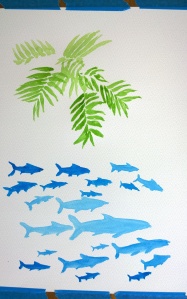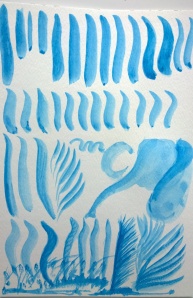Reading the instructions, this exercise is about creating simple shapes, initially, without too many details, but some nonetheless.
Fish need to look like fish, so I thought the simple oval was not enough. Most of them seeem to me quite two-dimensional, even altering the saturation of the paint did not help much.
Leaves, also painted on the same sheet of A3, as instructed, feels more realistic, and actually the shape is as I had intended at first, just the simple long oval.
Painting, washing off and painting again (the post I made earlier about this seems to have disappeared so am posting it again)
- painting the leaves on dry paper the paint stayed more or less where I put it and it was relatively easy for me to estimate how much paint and colour I needed.
- washing off the paint was harder than I imagined, in the sense that the paint did not all wash off under the tap but had to be wiped off till the desired effect was reached.
- after the wash had been applied, working into the wet wash had a different quality. The paint was much more likely to seep into surrounding areas and appear darker than I had anticipated.
- painting on paper that is dry after it has received a wash feels somewhere between the two. Easier to control but somehow the paper seems more willing to absorb the paint and show off the colours.
The effects achieved by painting on wet paper are probably unique to watercolour. This feels unfamiliar at the moment, but I am looking forward to trying to find ways of maximising these effects to good use.

A3 watercolour NOT 300g
Sap green washed off
Phthalo blue wash
Hooker’s green
Sap green
sable 10, squirrel 20









You must be logged in to post a comment.